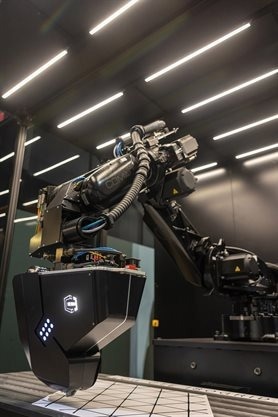Recently, at the University of Illinois Urbana-Champaign, a new piece of equipment was installed, bringing the newest additive manufacturing technology to campus. This equipment can print lightweight and large structural composites such as those employed in aerospace structures, unlike well-known metal or plastic additive manufacturing.

CF3D printer installed at the University of Illinois Urbana-Champaign. Image credits: University of Illinois Urbana-Champaign
It is the first continuous fiber 3D printer to be installed in academia and outside the company by Continuous Composites.
This is a paradigm-changing composite technology because it allows you to create structures with complex shapes that have mechanical properties approaching those of traditional aerospace composites. Currently, high-performance composites are made by laying resin-filled fabric or fibers by hand and cooking them for a long time in a pressure cooker called an autoclave.
Jeff Baur, Founder Professor, Engineering, University of Illinois Urbana-Champaign
Baur continued, "Now, we lay the fibers by robot, snap-cure them into shape and then cure them in an oven in a fraction of the time. Due to the strength of the continuous fibers, we believe we currently have the world’s strongest additively printed composite, but there is still a lot of technical work that needs to be done."
The CF3D printer has a special academic/industry partnership between UIUC and Continuous Composites, Inc. Baur stated the agreement with Continuous Composites would offer some tech support, supplies, and hardware updates to his laboratory. In response, he stated, “We’ll provide the company with free and open feedback about our experiences with the equipment so they can make improvements for their future customers.”
To lead the composite processing and additive manufacturing laboratory in the Department of Aerospace Engineering, Baur joined the faculty in 2022 after more than 25 years in the Air Force. At the Beckman Institute, he is also a part of the Autonomous Materials Systems Group.
I saw this technology coming four or five years ago. I knew where we were in terms of additive for polymers and it was clear to me that we would never get the mechanical properties we needed to be successful unless we went to very long or continuous fiber.
Jeff Baur, Founder Professor, Engineering, University of Illinois Urbana-Champaign
Additive manufacturing companies were surveyed by Baur as well as Composite World magazine with continuous carbon fiber. They reached the same conclusion: “For thermosetting composites like those used in the majority of aerospace applications, Continuous Composites was ahead of everyone else.”
Thermosetting composites are merged together with the use of chemical reactions—unlike those that need pressures and high temperatures to consolidate. This offers a rich palette of chemical options and properties, as well as utilizes less energy and facilitates more viable manufacturing at the “cradle” or beginning of the service life of the aerospace structure. Indeed, the huge impact for composites in sustainment is building vehicles lighter in weight, leading to less energy usage and minimal emissions over the vehicle’s lifespan.
Baur detailed one instance of how this novel technology could also address sustainability at the “grave” or at the end of the service life of a part. Owing to the durability of most thermosetting composites, it is challenging to recover the costly fiber from the resin matrix and again recycle or reuse either. Huge composite structures such as wind turbine blades, for instance, have a 30-year lifetime and are buried in landfills later.
Scientists are developing resin molecules that, in the right circumstances, could unzip to make the resin recyclable, the fibers recoverable, and both reusable. This was done through a recently awarded Department of Energy funded center, known as RE-MAT, and led by UIUC through the Beckman Institute.
The additive printed composite could expedite developing and evaluating these new materials and allow a circular economy for thermoset composites.
Along with a ceremonial ribbon-cutting, Baur hosted a symposium to bring together technical leaders from UIUC, Continuous Composites, the Air Force Research Lab, Arkema, Hexcel, Siemens, and Comeau.
Coordinating the event was important. “This isn’t the kind of thing that academia typically gets invited to,” Baur stated. “But at the symposium, we had participation from government, industry, and academia. It was a way to bring all the players together to have a conversation around a shared vision. Everybody wanted to see it. It was a big moment for the technology.”
According to Baur, the CF3D printer will be employed on multiple levels in research.
Imagine you have a new fiber, a new reinforcement, maybe a bio-derived fiber and you want to use it to make a structural composite. This machine should be able to handle that. At a completely different level, we can use this machine to make big structures like wind tunnel prototypes or structures that can be deployed in space. When you print with structural composites, your prototype can be at the performance level you need for the final structure.
Jeff Baur, Founder Professor, Engineering, University of Illinois Urbana-Champaign
Already, Baur has a group of aerospace students working on different projects.
“We can do work at the University of Illinois that is both fundamental and impactful to industry,” he added. “One of my students is developing new methods for topology optimization of these printed structures. One is working on shape-changing composites using novel composite designs. Another is working on characterizing the additive resin that will enable recyclable thermoset composites. And most will be using this machine in some capacity.”
“In the future, we’ll be looking at new materials, new formulations of composites, new designs of those composites, and new applications for those composites, including adaptive structures, and even multifunctionality with embedded devices,” he concludes.